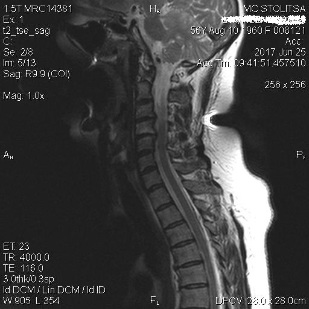Cervical osteochondrosis is a pathological change in the tissues of the intervertebral discs and vertebrae themselves. The result is thinning of the soft tissue, reduces the effect of cushioning the vertebrae. Is the compression of blood vessels and nerve fibers, reduced mobility of the cervical spine.
Cervical osteochondrosis - one of the most dangerous locations of osteochondrosis, because the disease worsens the blood supply of the brain.
How dangerous is cervical osteochondrosis
As a result of disrupted normal functioning of the cervical spine, the mobility decreases, pain in the neck. Cervical osteochondrosis can be the cause of the deterioration of cerebral blood flow, migraines, abnormal heart rhythm, blurred vision, coordination and attention, development of a herniated disc.
Osteochondrosis and spondylosis of the cervical spine
Symptoms of cervical degenerative disc disease
The disease is characterized by acute pain in the neck, nape, shoulders and forearms. The pain may be aggravated by head movement or in certain positions. The result of pain and the inflammatory process is strain the neck muscles. Patients often have headaches, hearing loss and vision, dizziness, tinnitus, sudden changes in blood pressure, fainting. Symptom of degenerative disc disease of the cervical could be a violation of the sensitivity of the tips of the fingers.
Causes of cervical degenerative disc disease
Causes of cervical degenerative disc disease typically associated with aging and age-related changes in tissues. However, lifestyle and its related factors increase the risk of disease. These include:
- low physical activity, sedentary work;
- excess weight and poor diet;
- diseases of the musculoskeletal apparatus: flat feet, arthritis, scoliosis, violation of posture;
- injuries in the neck and the back of the head.
In addition, low back pain can be caused by other diseases of the spine. The spine is a single unit, and treat it also need to. That is why the first thing to do if you suspect that osteochondrosis — a complete examination of the spine.
Treatment of cervical degenerative disc disease
Treatment is prescribed after examination. The doctor will gather a medical history and refer the patient for examination. Most commonly magnetic resonance imaging. Finding out the exact cause of the disease, start treatment.
In the acute phase, the doctor will prescribe painkillers and anti-inflammatory drugs. In the period of remission - physiotherapy — massage, shock wave therapy, physiotherapy. These methods are aimed at strengthening the corset muscles, relieve tension and prevent attacks of the disease.
Prevention of cervical degenerative disc disease
- Pass regular examinations. The disease is easier to prevent than to cure. Annual surveys will help to identify the disease at an early stage and cure it before it turned into a more serious stage.
- Follow the posture. Keep your back straight, shoulders relaxed. If you work at a computer or Desk, choose a comfortable chair, sit properly, do warm-up every half-hour.
- Keep an active lifestyle. The more you walk, be outdoors and do sports, especially swimming.
-
During sleep, use an orthopedic pillow.
















